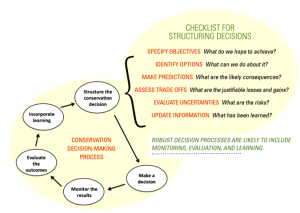Research Spotlight: Got Uncertainty? How to Deal with Uncertainty When Making Conservation Decisions


Consider the following example of how we deal with uncertainty in our everyday lives:
It’s 6:00 am. You look, bleary-eyed, out the window to see a calm sky with some clouds in the distance. You get up, get dressed, and prepare for the day. You pack your bag, grab your coffee, and head towards the door. You pause at the sight of your umbrella. Should you bring it? You quickly weigh the options of unnecessarily carrying the umbrella all day versus potentially getting rained on…
This familiar scenario demonstrates three things:
- we regularly face choices that require us to weigh the expected costs and benefits associated with different options;
- rarely are we absolutely certain about what will happen in the future; and
- imperfect information, by itself, does not prevent us from making choices.
Conservation practitioners must navigate the challenges of multiple societal and ecological uncertainties to advance effective natural-resource management. Despite these uncertainties and the fact that forecasts of the future are imperfect, decision makers are expected to communicate and use the information available when making policy choices that affect multiple user groups. The degree to which management objectives are met can depend on: 1) how critical uncertainties are identified and accounted for, and 2) effective communication among user groups, scientists, and resource managers. The objective of this Southeast CSC-funded project was to help facilitate strategic decision support related to communicating and using uncertain information in conservation decision making. We organized and held an interactive, interdisciplinary workshop, on the topic of “Communicating and Using Uncertain Information in Conservation Decision Making,” with a focus on the southeastern United States. Registrants were affiliated with universities as well as federal and state agencies.
Uncertainty is ever-present in socio-ecological decisions, which can make choices uncomfortable and challenging. Yet, all choices have consequences – including the choice to do nothing. Decision makers often are interested in tools that can formally account for known uncertainties when evaluating management alternatives. We produced a fact sheet that discusses the pervasiveness of uncertainty, the importance of understanding varying perceptions of uncertainty, and avenues for progress in the presence of uncertainty and differing risk tolerances.
 We detail four principles for robust conservation decision making.
We detail four principles for robust conservation decision making.
- Structure the decision. Formalizing decisions typically requires progression through several key steps while also confronting important questions related to both value-based objectives and impartial information.
- Recognize how values motivate. Even if perfect knowledge were obtainable, decision making would still be driven by value-based objectives.
- Heed evidence. Once a decision-relevant uncertainty is recognized, alternative plausible hypotheses should be defined and tested so that the empirical support for competing hypotheses can be established.
- Recognize how risk tolerances may vary. Even when objectives are shared, individuals can still react differently to uncertainty. Accounting for uncertainty within a decision-making framework helps make risks more transparent and helps define paths towards progressively well-informed future choices.
Project Leader: Brian Irwin, USGS Georgia Cooperative Fish and Wildlife Research Unit
Research Collaborators: University of Georgia, Michigan State University
Get more information on the SE CSC project page.
Download the Fact Sheet, “Turning Uncertainty into Useful Information for Conservation Decisions”
- Categories:
